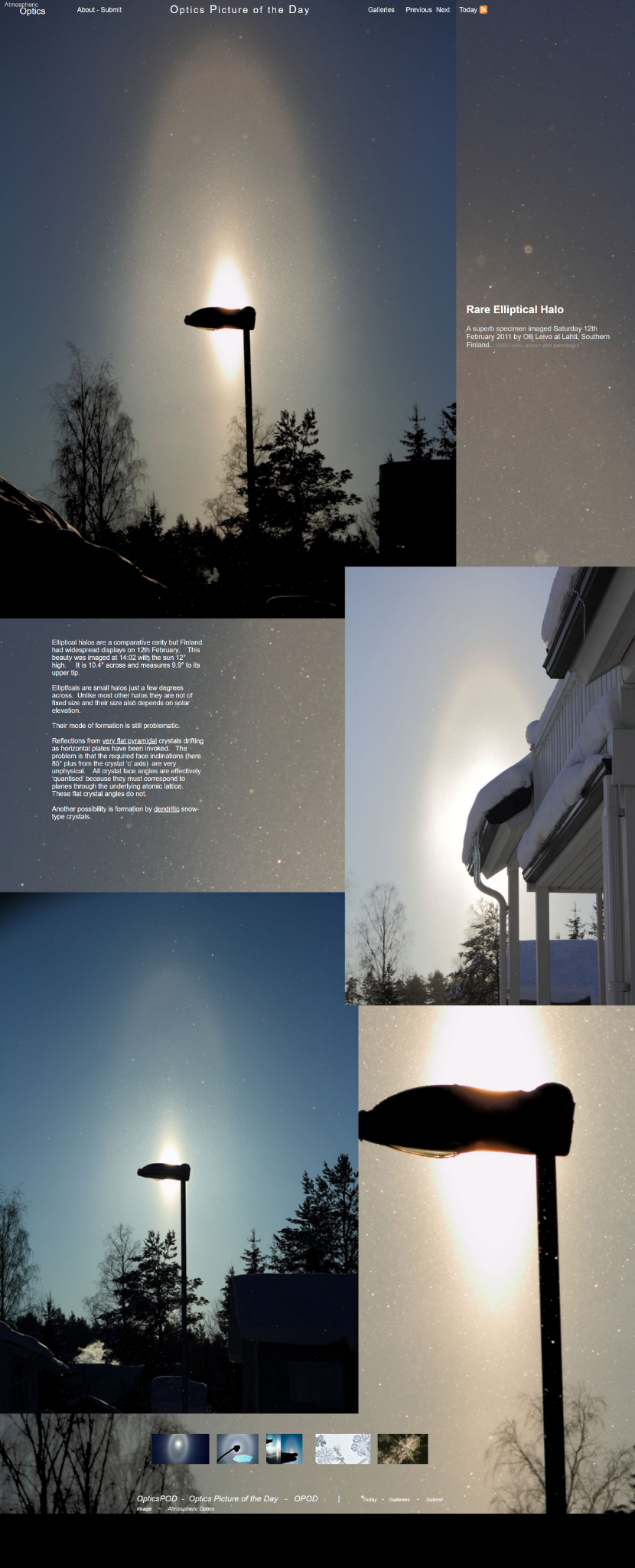OPOD - Rare Elliptical Halo
Rare Elliptical Halo: A Spectacular Atmospheric Phenomenon
The rare elliptical halo, a fascinating atmospheric optical phenomenon, captivates observers with its unique appearance. On February 12th, 2011, Olli Leivo from Lahti, Southern Finland, captured a superb image of this celestial wonder. Unlike the more commonly observed halos, elliptical halos are relatively uncommon occurrences. Finland experienced widespread displays of these captivating halos on that particular day.
Leivo's image, taken at 14:02 with the sun positioned 12° high, showcases the elliptical halo in all its glory. This particular halo measures 10.4° across and reaches a height of 9.9° at its upper tip. Its size varies and depends on the elevation of the sun, setting it apart from other halos that have fixed dimensions.
The formation of elliptical halos remains a puzzle for atmospheric scientists. Several theories attempt to explain their origin, but none have been definitively proven. Two prevailing hypotheses have emerged:
-
Reflections from Flat Pyramidal Crystals: One theory suggests that the elliptical halos form through the reflection of light by very flat pyramidal crystals drifting as horizontal plates. However, this theory encounters a significant challenge. The required face inclinations for these crystals, which are approximately 85° from the crystal's 'c' axis, are highly improbable in terms of their physical properties. Crystal face angles are typically quantized, as they must align with planes within the atomic lattice of the crystal. The flat angles necessary for this theory do not conform to this quantization.
-
Formation by Dendritic Snow-Type Crystals: An alternative explanation proposes that dendritic snow-type crystals contribute to the creation of elliptical halos. Dendritic crystals have a tree-like or branching structure, resembling delicate ice formations. These crystals may scatter light in a manner that produces the elliptical halo phenomenon. Further research is needed to confirm this hypothesis.
Despite the ongoing debate surrounding their formation, elliptical halos continue to captivate observers worldwide. These ethereal displays of light and color offer a glimpse into the intricacies of atmospheric optics. The rarity of these halos only enhances their allure, making them a sought-after sight for both amateur and professional photographers alike.
As we delve deeper into the mysteries of atmospheric optics, researchers and enthusiasts are continually striving to understand the complexities of these elusive phenomena. Each new observation provides valuable insights into the behavior of light as it interacts with the atmosphere's intricate components. By documenting and studying rare occurrences such as elliptical halos, scientists can expand their knowledge and refine existing theories.
It is worth noting that this article has been automatically converted from the old site and may not appear as intended. However, the essence of the information remains intact, offering readers an opportunity to explore the original article for a more comprehensive understanding of the subject matter.
In conclusion, the rare elliptical halo stands as a testament to the beauty and complexity of our atmosphere. Its enigmatic formation continues to challenge scientific understanding, leaving researchers intrigued and curious. As we uncover more about this captivating phenomenon, each observation brings us one step closer to unraveling the secrets of our ever-fascinating sky.

Rare Elliptical Halo
A superb specimen imaged Saturday 12th February 2011 by Olli Leivo at Lahti, Southern Finland. ©Olli Leivo, shown with permission.
Elliptical halos are a comparative rarity but Finland had widespread displays on 12th February. This beauty was imaged at 14:02 with the sun 12° high. It is 10.4° across and measures 9.9° to its upper tip.
Ellipticals are small halos just a few degrees across. Unlike most other halos they are not of fixed size and their size also depends on solar elevation.
Their mode of formation is still problematic.
Reflections from very flat pyramidal crystals drifting as horizontal plates have been invoked. The problem is that the required face inclinations (here 85° plus from the crystal ‘c’ axis) are very unphysical. All crystal face angles are effectively ‘quantised’ because they must correspond to planes through the underlying atomic lattice. These flat crystal angles do not.
Another possibility is formation by dendritic snow-type crystals.
Note: this article has been automatically converted from the old site and may not appear as intended. You can find the original article here.
Reference Atmospheric Optics
If you use any of the definitions, information, or data presented on Atmospheric Optics, please copy the link or reference below to properly credit us as the reference source. Thank you!
-
<a href="https://atoptics.co.uk/blog/opod-rare-elliptical-halo/">OPOD - Rare Elliptical Halo</a>
-
"OPOD - Rare Elliptical Halo". Atmospheric Optics. Accessed on December 22, 2024. https://atoptics.co.uk/blog/opod-rare-elliptical-halo/.
-
"OPOD - Rare Elliptical Halo". Atmospheric Optics, https://atoptics.co.uk/blog/opod-rare-elliptical-halo/. Accessed 22 December, 2024
-
OPOD - Rare Elliptical Halo. Atmospheric Optics. Retrieved from https://atoptics.co.uk/blog/opod-rare-elliptical-halo/.